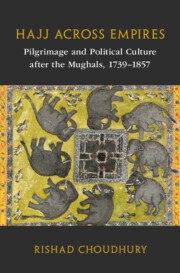Book contents
- Hajj across Empires
- Asian Connections
- Hajj across Empires
- Copyright page
- Dedication
- Epigraph
- Contents
- Figures
- Maps
- Tables
- Preface and Acknowledgments
- Note on Transliterations and Translations
- Abbreviations
- Maps
- Introduction
- Part I Departures
- Part II Crossings
- Part III Returns
- 5 The Company Raj and the Hajjis
- 6 Routes of the Muslim State
- 7 Faqirs and Fanatics, or, Reconfiguring Pilgrimage and Political Culture
- Conclusion
- Bibliography
- Index
- Asian Connections
Conclusion
The Hajj and the Ends of the Mughal World
from Part III - Returns
Published online by Cambridge University Press: 01 February 2024
- Hajj across Empires
- Asian Connections
- Hajj across Empires
- Copyright page
- Dedication
- Epigraph
- Contents
- Figures
- Maps
- Tables
- Preface and Acknowledgments
- Note on Transliterations and Translations
- Abbreviations
- Maps
- Introduction
- Part I Departures
- Part II Crossings
- Part III Returns
- 5 The Company Raj and the Hajjis
- 6 Routes of the Muslim State
- 7 Faqirs and Fanatics, or, Reconfiguring Pilgrimage and Political Culture
- Conclusion
- Bibliography
- Index
- Asian Connections
Summary
What implications does this book have for the study of South Asian history? In a recent historiographical intervention, Muzaffar Alam and Sanjay Subrahmanyam invited further comparative reflections on the Mughals and their counterparts and contemporaries. In addition, they noted how the “sensitive matter of ‘eighteenth-century decline’” should be examined not only by following the fortunes of the late Mughal dynasty, but by turning to the perspectives of those polities and agents whose fates became implicated with the devolution of power in South Asia – regional successor states, middling social groups, and, of course, the East India Company state.1 As the preceding chapters sought to argue, these empirical and analytical themes are unquestionably important in giving us a fuller and richer understanding of how political culture in South Asia transformed after the Mughals. Yet, as this study has also contended, regional histories from the Subcontinent perhaps alone cannot tell the entire story. By turning to a transregional regime of circulation like the hajj pilgrimage – an “old” terrain of exchange with the Middle East that the Mughals actively helped establish – we ultimately acquire another set of perspectives on how “new” political cultures emerged in South Asia as the Timurid empire entered its long century of decline and decentralization.
- Type
- Chapter
- Information
- Hajj across EmpiresPilgrimage and Political Culture after the Mughals, 1739–1857, pp. 299 - 302Publisher: Cambridge University PressPrint publication year: 2024

